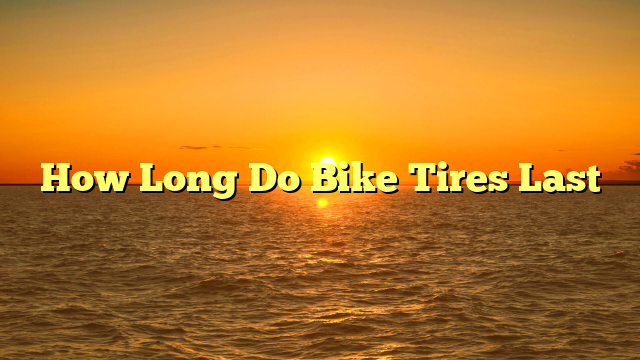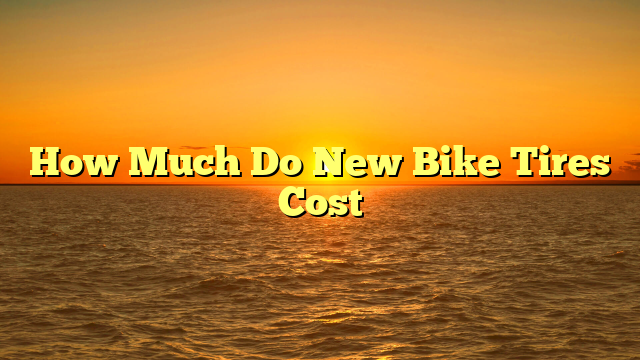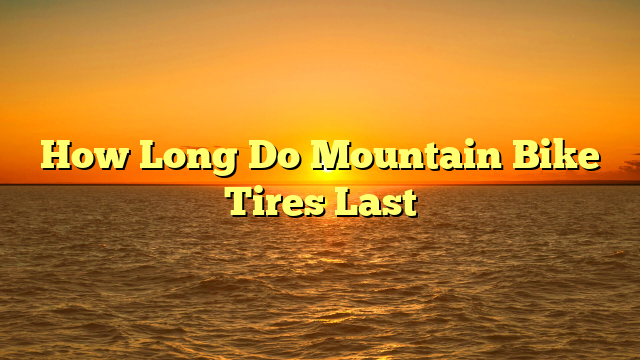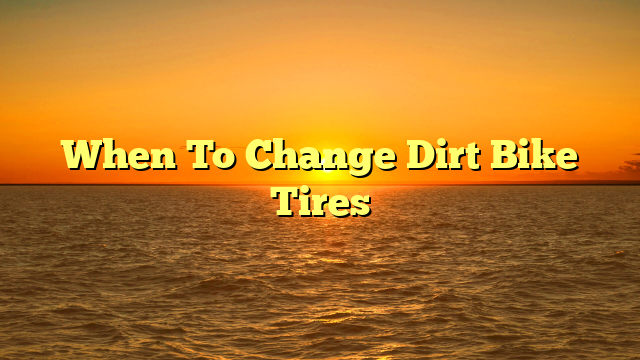As a cycling enthusiast, I have often wondered how long my bike tires can last.
After all, they are an essential component of my rides, and their condition can affect my overall performance and safety.
So, I decided to research and find out the answer to this question.
In this article, I will share my findings on how long bike tires last, the factors that affect their lifespan, and tips on how to extend their durability.
Firstly, it’s important to understand that bike tires can vary in their longevity depending on their type, quality, and usage.
From road to mountain bikes, there are different tire options available, each with its own recommended lifespan.
Additionally, factors such as riding terrain, frequency of use, and proper maintenance can impact tire wear and tear.
By learning about these factors, you can effectively manage your tire’s lifespan, ensure optimal performance, and save money in the long run.
Table of Contents
- 1 Key Takeaways
- 2 Types of Bike Tires and Their Lifespan
- 3 Factors that Affect Bike Tire Longevity
- 4 Riding Terrain and Its Impact on Tire Wear
- 5 Frequency of Use and Tire Replacement
- 6 Signs that Indicate Your Bike Tires Need Replacing
- 7 Tips for Extending the Lifespan of Your Tires
- 8 Proper Tire Maintenance for Maximum Durability
- 9 Choosing the Right Tires for Your Riding Style and Needs
- 10 Frequently Asked Questions
- 11 Conclusion
Key Takeaways
- Bike tire lifespan is affected by factors such as type, quality, usage, weather, and terrain.
- Tubeless tires generally last longer than tubed tires, and higher-quality tires from reputable brands tend to have a longer lifespan.
- Signs that indicate bike tires need replacing include worn-down treads, cracks or cuts on the sidewall, consistently low tire pressure, the wobbly sensation when riding, and misshapen or flat spots.
- Proper tire maintenance, including monitoring tire pressure and tread wear, cleaning tires, and storing them in a cool, dry place away from direct sunlight and heat sources, can help prolong tire lifespan and ensure a safe ride.
Types of Bike Tires and Their Lifespan
You’ll want to know the types of bike tires and how long they’ll last, so you can make sure you’re getting the most out of your ride and your investment.
One type of bike tire that has gained popularity in recent years is the tubeless tire.
These tires don’t have an inner tube and instead rely on a sealant to prevent punctures.
They tend to have a longer lifespan than tubed tires because they’re less likely to get flats.
However, they can be more expensive and require a special setup process.
Tubed tires, on the other hand, have been around for much longer and are still the most common type of bike tire.
They’re less expensive than tubeless tires and can be easily replaced if they get a puncture.
However, they’re more prone to flats and generally have a shorter lifespan.
When it comes to brands and quality, it’s important to remember that not all tires are created equal.
Higher-quality tires from reputable brands will generally last longer than cheaper, lower-quality options.
It’s worth investing in a good set of tires to ensure that you get the most mileage out of them.
Factors that Affect Bike Tire Longevity
Don’t overlook the impact of your riding style and the terrain you choose on the lifespan of your trusty rubber companions.
Even the highest quality, most durable bike tires will wear out more quickly if subjected to harsh conditions.
One of the most critical factors that affect tire longevity is tire pressure.
Riding with too little or too much air in your tires can cause excessive wear and tear on the rubber, leading to premature failure.
Make sure to check your tire pressure regularly, especially before long rides or after a period of storage.
Another crucial factor is weather conditions.
Exposure to UV rays, extreme temperatures, and moisture can all contribute to tire degradation.
Storing your bike in a cool, dry place when not in use can help minimize the effects of weathering.
Additionally, you should be mindful of the terrain you ride on.
Rough, rocky, or uneven surfaces can cause more damage to your tires than smooth pavement or dirt paths.
By being aware of the potential impact of these factors, you can take steps to extend the life of your bike tires and get the most out of your investment.
| Tire Pressure | Weather Conditions |
|---|---|
| Check tire pressure regularly | Store bike in cool, dry place |
| Avoid riding with too little or too much air | Minimize exposure to UV rays |
| Adjust tire pressure before long rides | Avoid extreme temperatures |
| Avoid riding in wet or damp conditions |
Riding Terrain and Its Impact on Tire Wear
The type of terrain you choose to ride on can have a significant impact on how quickly your bike tires wear out.
Off-road wear is one of the main factors that can damage your bike tires.
The rough and rocky terrain can cause punctures and cuts on the tire, leading to premature wear and tear.
Additionally, the gravel, sand, and mud on the off-road trails can also cause the tire treads to wear out quickly, reducing the overall lifespan of your bike tires.
City riding impact is another major factor that affects the longevity of your bike tires.
The constant start and stop the motion of city riding can cause the tires to wear out faster than if you were riding on a straight and smooth road.
The rough and uneven city streets can cause the rubber of the tires to weaken and crack over time, leading to a shorter lifespan.
It’s important to choose the right tires for the type of terrain you’ll be riding on to ensure that you get the most out of your bike tires.
Frequency of Use and Tire Replacement
If you ride your bike often, it’s likely that you’ll need to replace your tires sooner rather than later.
Frequent use can cause wear and tear to the tires, especially if you ride on rough terrain.
It’s important to keep an eye on your tires and replace them when necessary to ensure your safety while riding.
Aside from frequent use, another factor that affects tire wear is proper tire pressure and storage.
Underinflated tires can cause excessive wear on the sidewalls, while overinflated tires can lead to premature tread wear.
It’s important to maintain proper tire pressure in order to maximize the lifespan of your tires.
Additionally, proper storage can also help prolong the life of your tires.
Keeping them in a cool, dry place and avoiding exposure to direct sunlight can help prevent cracking and other forms of damage.
By taking care of your tires and replacing them when necessary, you can enjoy a safe and smooth ride.
Signs that Indicate Your Bike Tires Need Replacing
You’ll know it’s time to replace your bike tires when you feel a sudden loss of grip and notice deep cuts or worn-down treads.
Tire wear is a natural occurrence that happens over time, especially if you use your bike frequently.
However, it’s important to keep an eye on your tire’s condition so that you can replace them before they become a safety hazard.
Here are five signs that indicate your bike tires need replacing:
- The tread is worn down to the point where it’s almost smooth.
- You notice cracks or cuts on the sidewall of the tire.
- The tire pressure is consistently low even after inflating it.
- You feel a wobbly sensation when riding, which could indicate a bulge in the tire.
- You notice that the tire looks misshapen or has a flat spot, which could be a sign of internal damage.
By being aware of these signs, you can ensure that your bike is always in top condition and that you’re safe while riding.
Remember, regularly checking your tire wear and pressure is an essential part of bike maintenance.
Tips for Extending the Lifespan of Your Tires
To extend the lifespan of your bike tires, it’s important to regularly clean them with a damp cloth and avoid harsh chemicals.
This will help to prevent any damage to the tire’s rubber and keep them in good condition.
It’s also important to properly manage your tire pressure.
Make sure to check your tire pressure regularly and adjust it to the recommended level.
This will not only help to extend the life of your tires but also improve your overall riding experience.
Another important factor to consider when extending the lifespan of your bike tires is the way you store them.
To prevent any damage, it’s best to store your tires in a cool, dry place away from direct sunlight and heat sources.
It’s also important to keep them away from any sharp objects or materials that may puncture the rubber.
By following these simple tips, you can help to extend the lifespan of your bike tires and save money in the long run.
Proper Tire Maintenance for Maximum Durability
Maintaining your tires properly is crucial for getting the most out of them and ensuring they stay durable.
One of the most important aspects of tire maintenance is monitoring tire pressure.
Riding with tires that are over or underinflated can lead to premature wear and tear, decreased fuel efficiency, and even dangerous blowouts.
It’s important to check your tire pressure regularly, ideally, every two weeks, to ensure they are properly inflated.
You can find the recommended tire pressure in your owner’s manual or on the tire itself.
Another key aspect of tire maintenance is monitoring tread wear.
The tread on your tires is what provides the necessary traction for safe driving.
As the tread wears down, the tire becomes less effective at gripping the road, increasing your risk of accidents.
You should check your tire tread depth regularly, at least once a month, using a tread depth gauge or by looking for the wear bars on the tire itself.
If your tread is getting low, it’s time to replace your tires to ensure your safety on the road.
| Tire Pressure | Too Low | Recommended | Too High |
|---|---|---|---|
| Passenger Cars | Below 28 PSI | 30-35 PSI | Above 40 PSI |
| Light Trucks | Below 26 PSI | 35-40 PSI | Above 45 PSI |
| Motorcycles | Below 20 PSI | 30-35 PSI | Above 40 PSI |
Monitoring tire pressure and tread wear may require a little extra effort, but doing so can save you money in the long run by extending the life of your tires and ensuring they perform as they should.
Don’t wait until it’s too late to check your tire pressure or tread wear – make it a regular part of your maintenance routine.
Choosing the Right Tires for Your Riding Style and Needs
Finding the perfect tires to match your unique riding style and needs can greatly enhance your overall riding experience.
There are a variety of factors to consider when choosing the right tires, including tubeless vs.
tubed options, tread patterns, and tire materials.
Here are some key points to keep in mind:
- Tubeless tires can offer better puncture protection and a smoother ride, but they may require more maintenance and can be trickier to install.
- Tread patterns can affect your bike’s traction and handling in different weather conditions, so think about the types of surfaces you’ll be riding on most frequently.
- Tire materials can impact both durability and performance.
For example, some tires are made with softer rubber compounds that provide better grip but may not last as long as harder compounds.
- It’s important to find a balance between durability and performance, depending on your riding style and needs.
A more aggressive rider may prioritize performance over longevity, while a casual rider may be willing to sacrifice some performance for a longer-lasting tire.
- Don’t forget to check the sizing and compatibility of your chosen tires with your bike’s rims and brakes.
By taking the time to research and choose the right tires for your needs, you can enjoy a more comfortable, efficient, and safe ride.
Frequently Asked Questions
How do I know what size bike tire I need?
To determine the correct bike tire size, measure the diameter of the wheel and consult a size chart.
Popular brands of high-performance tires include Continental, Schwalbe, and Maxxis.
Can I use any type of tire on my bike or are there specific types?
There are specific types of tires for bikes, and it’s important to choose the right one for your needs.
Tubeless tires are becoming more popular, but they require a special rim.
Tread type should be chosen based on terrain and riding style.
Is it safe to ride on old or worn tires?
Risks are involved when riding on old or worn bike tires.
Tire replacement is crucial for safety.
Signs of wear include cracks, bulges, and worn-out treads.
Regularly check and replace tires to avoid accidents.
How often should I check my tire pressure?
I check my tire pressure before every ride to ensure proper inflation.
Benefits of proper inflation include improved handling, reduced rolling resistance, and increased tire longevity.
Common causes of underinflation are temperature changes and slow leaks.
Are there any eco-friendly bike tire options available?
I am exploring eco-friendly options for bike tires and have found that recycled rubber is a sustainable choice.
Additionally, natural rubber has benefits in bike tire manufacturing, such as improved grip and durability.
Conclusion
Overall, the lifespan of your bike tires will depend on a variety of factors, including the type of tire, the terrain you ride on, and how often you use your bike.
While some tires may last for several years with proper maintenance and care, others may need to be replaced after just a few months of use.
To ensure your bike tires last, as long as possible, it’s important to choose the right tires for your riding style and needs.
You should properly maintain them by keeping them inflated to the correct pressure, checking them regularly for signs of wear or damage, and replacing them when necessary.
By following these tips and taking good care of your tires, you can help extend their lifespan.
This will allow you to enjoy a safe and comfortable ride every time you hit the road or trail.



![How Long Do Bikes Last? [Durability and Lifespan] How Long Do Bikes Last [Durability and Lifespan]](https://www.ridefoster.com/wp-content/uploads/2023/05/How-Long-Do-Bikes-Last-Durability-and-Lifespan.webp)



